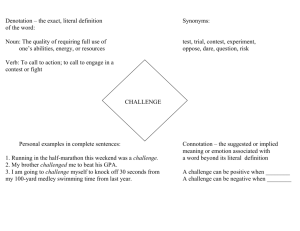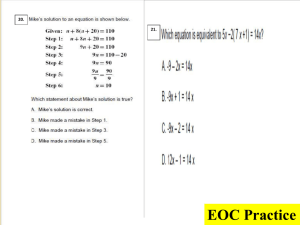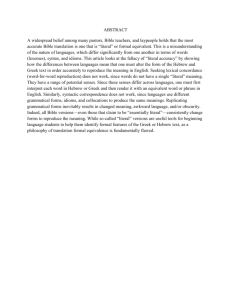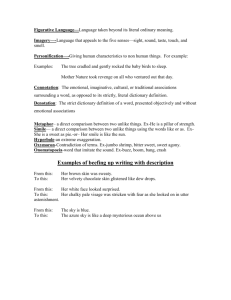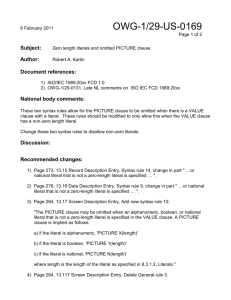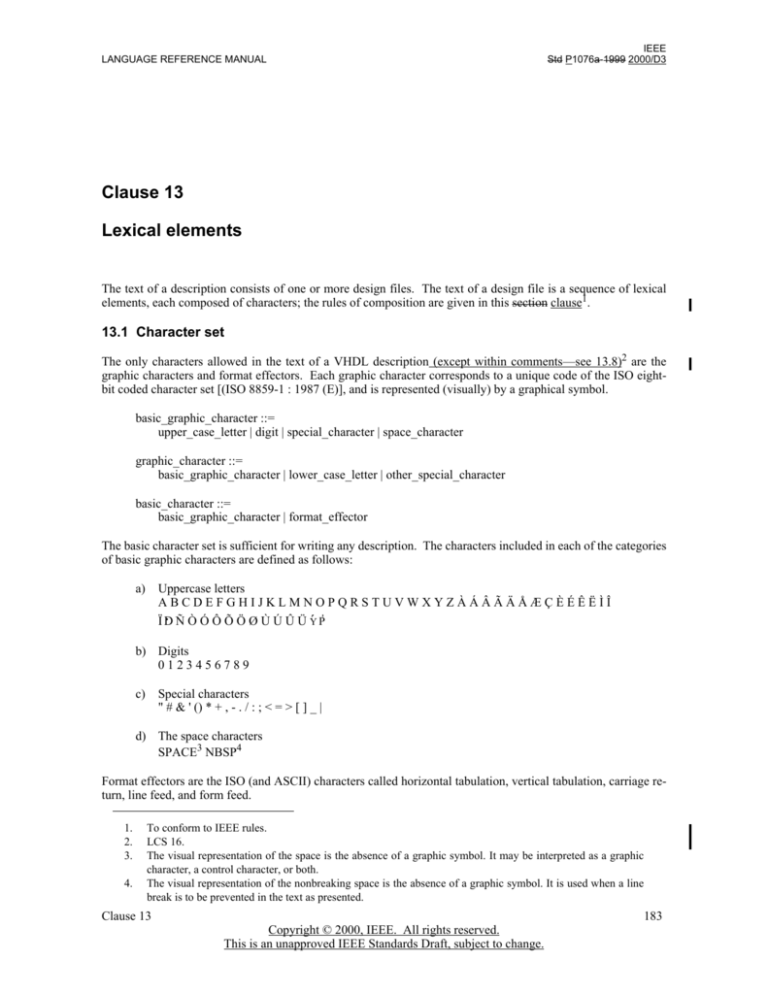
LANGUAGE REFERENCE MANUAL
IEEE
Std P1076a-1999 2000/D3
Clause 13
Lexical elements
The text of a description consists of one or more design files. The text of a design file is a sequence of lexical
elements, each composed of characters; the rules of composition are given in this section clause1.
13.1 Character set
The only characters allowed in the text of a VHDL description (except within comments—see 13.8)2 are the
graphic characters and format effectors. Each graphic character corresponds to a unique code of the ISO eightbit coded character set [(ISO 8859-1 : 1987 (E)], and is represented (visually) by a graphical symbol.
basic_graphic_character ::=
upper_case_letter | digit | special_character | space_character
graphic_character ::=
basic_graphic_character | lower_case_letter | other_special_character
basic_character ::=
basic_graphic_character | format_effector
The basic character set is sufficient for writing any description. The characters included in each of the categories
of basic graphic characters are defined as follows:
a)
Uppercase letters
ABCDEFGHIJKLMNOPQRSTUVWXYZÀÁÂÃÄÅÆÇÈÉÊËÌÎ
. ÑÒÓÔÕÖØÙÚÛÜY
ÏD
´ P'
b) Digits
0123456789
c)
Special characters
" # & ' () * + , - . / : ; < = > [ ] _ |
d) The space characters
SPACE3 NBSP4
Format effectors are the ISO (and ASCII) characters called horizontal tabulation, vertical tabulation, carriage return, line feed, and form feed.
1.
2.
3.
4.
To conform to IEEE rules.
LCS 16.
The visual representation of the space is the absence of a graphic symbol. It may be interpreted as a graphic
character, a control character, or both.
The visual representation of the nonbreaking space is the absence of a graphic symbol. It is used when a line
break is to be prevented in the text as presented.
Clause 13
183
Copyright © 2000, IEEE. All rights reserved.
This is an unapproved IEEE Standards Draft, subject to change.
IEEE
Std P1076a-1999 2000/D3
IEEE STANDARD VHDL
The characters included in each of the remaining categories of graphic characters are defined as follows:
e)
Lowercase letters
a b c d e f g h i j k l m n o p q r s t u v w x y z ß à á â ã ä å æ ç è é ê ë í î ï ∂´ ñ ò ó ô
õ ö ø ù ú û ü ý p' ÿ
f)
Other special characters
!$%@?\^`{}~¡¢£ ¥
|
|
§ ¨ © ª « ¬ -® ¯ ° ± 2 3 ´ µ ¶ • ¸ 1 º » 1/4 1/2 3/4 ¿ × ÷ - (soft hyphen)
Allowable replacements for the special characters vertical line (|), number sign (#), and quotation mark (") are defined in the last clause of this section 13.105.
NOTES
1—The font design of graphical symbols (for example, whether they are in italic or bold typeface) is not part of ISO 88591:1987.
2—The meanings of the acronyms used in this section clause6 are as follows: ASCII stands for American Standard Code for
Information Interchange, ISO stands for International Organization for Standardization.
3—There are no uppercase equivalents for the characters ß and ÿ.
4—The following names are used when referring to special characters:
Character
Name
Character
Name
Character
Name
"
#
quotation mark
number sign
?
@
question mark
commercial at
®
&
'
ampersand
apostrophe, tick
[
\
(
)
*
+
,
.
]
^
`
{
}
~
¡
/
:
;
left parenthesis
right parenthesis
asterisk, multiply
plus sign
comma
hyphen, minus sign
dot, point, period,
full stop
slash, divide, solidus
colon
semicolon
soft hyphen
registered trade
mark sign
macron
ring above, degree
sign
plus-minus sign
superscript two
superscript three
acute accent
micro sign
pilcrow sign
middle dot
<
less-than sign
¥
yen sign
»
=
equals sign
|
|
broken bar
1/
4
>
greater-than sign
§
1/
2
_
underline, low line
¨
paragraph sign, section sign
diaeresis
|
©
copyright sign
¿
!
vertical line, vertical
bar
exclamation mark
ª
×
$
dollar sign
«
%
percent sign
¬
feminine ordinal
indicator
left angle quotation
mark
not sign
5.
6.
¢
£
left square bracket
backslash, reverse
solidus
right square bracket
circumflex accent
grave accent
left curly bracket
right curly bracket
tilde
inverted exclamation
mark
cent sign
pound sign
currency sign
º
¯
°
±
2
3
´
µ
¶
•
¸
1
3/
4
÷
cedilla
superscript one
masculine ordinal
indicator
right angle quotation
mark
vulgar fraction one
quarter
vulgar fraction one
half
vulgar fraction three
quarters
inverted question
mark
multiplication sign
division sign
To conform to IEEE rules.
To conform to IEEE rules.
184
Clause 13
Copyright © 2000, IEEE. All rights reserved.
This is an unapproved IEEE Standards Draft, subject to change.
IEEE
Std P1076a-1999 2000/D3
LANGUAGE REFERENCE MANUAL
The soft hyphen is a graphic character that is imaged by a graphic symbol identical with, or similar to, that representing
HYPHEN, for use when a line break has been established within a work.
13.2 Lexical elements, separators, and delimiters
The text of each design unit is a sequence of separate lexical elements. Each lexical element is either a delimiter,
an identifier (which may be a reserved word), an abstract literal, a character literal, a string literal, a bit string literal, or a comment.
In some cases an explicit separator is required to separate adjacent lexical elements (namely when, without separation, interpretation as a single lexical element is possible). A separator is either a space character (SPACE or
NBSP), a format effector, or the end of a line. A space character (SPACE or NBSP) is a separator except within
an extended identifier,7 a comment, a string literal, or a space character literal.
The end of a line is always a separator. The language does not define what causes the end of a line. However if,
for a given implementation, the end of a line is signified by one or more characters, then these characters must be
format effectors other than horizontal tabulation. In any case, a sequence of one or more format effectors other
than horizontal tabulation must cause at least one end-of-line.
One or more separators are allowed between any two adjacent lexical elements, before the first of each design unit
or after the last lexical element of a design file. At least one separator is required between an identifier or an abstract literal and an adjacent identifier or abstract literal.
A delimiter is either one of the following special characters (in the basic character set):
& ' ( ) * + , - . / : ; < = > |[]
or one of the following compound delimiters, each composed of two adjacent special characters:
=> ** := /= >= <= <>
Each of the special characters listed for single character delimiters is a single delimiter except if this character is
used as a character of a compound delimiter or as a character of an extended identifier,8 a comment, string literal,
character literal, or abstract literal.
The remaining forms of lexical elements are described in other clause of this section subclauses of this clause9.
NOTES
1—Each lexical element must fit on one line, since the end of a line is a separator. The quotation mark, number sign, and
underline characters, likewise two adjacent hyphens, are not delimiters, but may form part of other lexical elements.
2—The following names are used when referring to compound delimiters:
7.
8.
9.
Delimiter
Name
=>
**
:=
/=
>=
<=
<>
arrow
double star, exponentiate
variable assignment
inequality (pronounced “not equal”)
greater than or equal
less than or equal; signal assignment
box
IR1000.3.1.
IR1000.3.1.
To conform to IEEE rules.
Clause 13
185
Copyright © 2000, IEEE. All rights reserved.
This is an unapproved IEEE Standards Draft, subject to change.
IEEE
Std P1076a-1999 2000/D3
IEEE STANDARD VHDL
13.3 Identifiers
Identifiers are used as names and also as reserved words.
identifier ::= basic_identifier | extended_identifier
13.3.1 Basic identifiers
A basic identifier consists only of letters, digits, and underlines.
basic_identifier ::=
letter { [ underline ] letter_or_digit }
letter_or_digit ::= letter | digit
letter ::= upper_case_letter | lower_case_letter
All characters of a basic identifier are significant, including any underline character inserted between a letter or
digit and an adjacent letter or digit. Basic identifiers differing only in the use of corresponding uppercase and
lowercase letters are considered the same.
Examples:
COUNT
X
c_out
FFT
Decoder
VHSIC
X1
PageCount
STORE_NEXT_ITEM
NOTE
—No space (SPACE or NBSP) is allowed within a basic identifier since a space is a separator.
13.3.2 Extended identifiers
Extended identifiers may contain any graphic character.
extended_identifier ::=
\ graphic_character { graphic_character } \
If a backslash is to be used as one of the graphic characters of an extended literal, it must be doubled. All characters of an extended identifier are significant (a doubled backslash counting as one character). Extended identifiers
differing only in the use of corresponding uppercase and lowercase letters are distinct. Moreover, every extended
identifier is distinct from any basic identifier.
Examples:
\BUS\
\bus\
-- Two different identifiers, neither of which is
-- the reserved word bus.
\a\\b\
VHDL
-- An identifier containing three characters.
\VHDL\
\vhdl\
-- Three distinct identifiers.
186
Clause 13
Copyright © 2000, IEEE. All rights reserved.
This is an unapproved IEEE Standards Draft, subject to change.
IEEE
Std P1076a-1999 2000/D3
LANGUAGE REFERENCE MANUAL
13.4 Abstract literals
There are two classes of abstract literals: real literals and integer literals. A real literal is an abstract literal that
includes a point; an integer literal is an abstract literal without a point. Real literals are the literals of the type
universal_real. Integer literals are the literals of the type universal_integer.
abstract_literal ::= decimal_literal | based_literal
13.4.1 Decimal literals
A decimal literal is an abstract literal expressed in the conventional decimal notation (that is, the base is implicitly
ten).
decimal_literal ::= integer [ . integer ] [ exponent ]
integer ::= digit { [ underline ] digit }
exponent ::= E [ + ] integer | E – integer
An underline character inserted between adjacent digits of a decimal literal does not affect the value of this abstract literal. The letter E of the exponent, if any, can be written either in lowercase or in uppercase, with the same
meaning.
An exponent indicates the power of ten by which the value of the decimal literal without the exponent is to be
multiplied to obtain the value of the decimal literal with the exponent. An exponent for an integer literal must not
have a minus sign.
Examples:
12
0
1E6
123_456
-- Integer literals
12.0
0.0
0.456
3.14159_26
-- Real literals
1.34E–12
1.0E+6
6.023E+24
-- Real literals with exponents
NOTE
—Leading zeros are allowed. No space (SPACE or NBSP) is allowed in an abstract literal, not even between constituents of
the exponent, since a space is a separator. A zero exponent is allowed for an integer literal.
13.4.2 Based literals
A based literal is an abstract literal expressed in a form that specifies the base explicitly. The base must be at least
two and at most sixteen.
based_literal ::=
base # based_integer [ . based_integer ] # [ exponent ]
base ::= integer
based_integer ::=
extended_digit { [ underline ] extended_digit }
extended_digit ::= digit | letter
An underline character inserted between adjacent digits of a based literal does not affect the value of this abstract
literal. The base and the exponent, if any, are in decimal notation. The only letters allowed as extended digits are
Clause 13
187
Copyright © 2000, IEEE. All rights reserved.
This is an unapproved IEEE Standards Draft, subject to change.
IEEE
Std P1076a-1999 2000/D3
IEEE STANDARD VHDL
the letters A through F for the digits ten through fifteen. A letter in a based literal (either an extended digit or the
letter E of an exponent) can be written either in lowercase or in uppercase, with the same meaning.
The conventional meaning of based notation is assumed; in particular the value of each extended digit of a based
literal must be less than the base. An exponent indicates the power of the base by which the value of the based
literal without the exponent is to be multiplied to obtain the value of the based literal with the exponent. An exponent for a based integer literal must not have a minus sign.
Examples:
-- Integer literals of value 255:
2#1111_1111#
16#FF#
016#0FF#
-- Integer literals of value 224:
16#E#E1
2#1110_0000#
-- Real literals of value 4095.0:
16#F.FF#E+2
2#1.1111_1111_111#E11
13.5 Character literals
A character literal is formed by enclosing one of the 191 graphic characters (including the space and nonbreaking
space characters) between two apostrophe characters. A character literal has a value that belongs to a character
type.
character_literal ::= ' graphic_character '
Examples:
'A' '*' ''' ' '
13.6 String literals
A string literal is formed by a sequence of graphic characters (possibly none) enclosed between two quotation
marks used as string brackets.
string_literal ::= “ { graphic_character } “ " { graphic_character } "10
A string literal has a value that is a sequence of character values corresponding to the graphic characters of the
string literal apart from the quotation mark itself. If a quotation-mark value is to be represented in the sequence
of character values, then a pair of adjacent quotation marks must be written at the corresponding place within the
string literal. (This means that a string literal that includes two adjacent quotation marks is never interpreted as
two adjacent string literals.)
The length of a string literal is the number of character values in the sequence represented. (Each doubled quotation mark is counted as a single character.)
Examples:
"Setup time is too short"
-- An error message.
""
-- An empty string literal.
""
"A"
""""
-- Three string literals of length 1.
10. Boyer.
188
Clause 13
Copyright © 2000, IEEE. All rights reserved.
This is an unapproved IEEE Standards Draft, subject to change.
IEEE
Std P1076a-1999 2000/D3
LANGUAGE REFERENCE MANUAL
"Characters such as $, %, and } are allowed in string literals."
NOTE
—A string literal must fit on one line, since it is a lexical element (see 13.2). Longer sequences of graphic character values
can be obtained by concatenation of string literals. The concatenation operation may also be used to obtain string literals
containing nongraphic character values. The predefined type CHARACTER in package STANDARD specifies the enumeration literals denoting both graphic and nongraphic characters. Examples of such uses of concatenation are
"FIRST PART OF A SEQUENCE OF CHARACTERS " &
"THAT CONTINUES ON THE NEXT LINE"
"Sequence that includes the" & ACK & "control character"
13.7 Bit string literals
A bit string literal is formed by a sequence of extended digits (possibly none) enclosed between two quotations
used as bit string brackets, preceded by a base specifier.
bit_string_literal ::= base_specifier " [ bit_value ] "
bit_value ::= extended_digit { [ underline ] extended_digit }
base_specifier ::= B | O | X
An underline character inserted between adjacent digits of a bit string literal does not affect the value of this literal.
The only letters allowed as extended digits are the letters A through F for the digits ten through fifteen. A letter
in a bit string literal (either an extended digit or the base specifier) can be written either in lowercase or in uppercase, with the same meaning.
If the base specifier is 'B', the extended digits in the bit value are restricted to 0 and 1. If the base specifier is 'O',
the extended digits in the bit value are restricted to legal digits in the octal number system, i.e., the digits 0 through
7. If the base specifier is 'X', the extended digits are all digits together with the letters A through F.
A bit string literal has a value that is a string literal consisting of the character literals '0' and '1'. If the base specifier is 'B', the value of the bit string literal is the sequence given explicitly by the bit value itself after any underlines have been removed.
If the base specifier is 'O' (respectively 'X'), the value of the bit string literal is the sequence obtained by replacing
each extended digit in the bit_value by a sequence consisting of the three (respectively four) values representing
that extended digit taken from the character literals '0' and '1'; as in the case of the base specifier 'B', underlines
are first removed. Each extended digit is replaced according to this table:
Extended digit
0
1
2
3
4
5
6
7
8
Replacement when the base specifier is
'O'
000
001
010
011
100
101
110
111
(illegal)
Replacement when the base specifier is
'X'
0000
0001
0010
0011
0100
0101
0110
0111
1000
Clause 13
189
Copyright © 2000, IEEE. All rights reserved.
This is an unapproved IEEE Standards Draft, subject to change.
IEEE
Std P1076a-1999 2000/D3
IEEE STANDARD VHDL
9
A
B
C
D
E
F
(illegal)
(illegal)
(illegal)
(illegal)
(illegal)
(illegal)
(illegal)
1001
1010
1011
1100
1101
1110
1111
The length of a bit string literal is the length of its string literal value.
Examples:
B"1111_1111_1111"-- Equivalent to the string literal "111111111111"
X"FFF"
-- Equivalent to B"1111_1111_1111"
O"777"
-- Equivalent to B"111_111_111"
X"777"
-- Equivalent to B"0111_0111_0111"
constant c1: STRING := B"1111_1111_1111";
constant c2: BIT_VECTOR := X"FFF";
type MVL is ('X', '0', '1', 'Z');
type MVL_VECTOR is array (NATURAL range <>) of MVL;
constant c3: MVL_VECTOR := O"777";
assert
c1'LENGTH = 12 and
c2'LENGTH = 12 and
c3 = "111111111";
13.8 Comments
A comment starts with two adjacent hyphens and extends up to the end of the line. A comment can appear on any
line of a VHDL description and may contain any character except the format effectors vertical tab, carriage return
line feed, and form feed11. The presence or absence of comments has no influence on whether a description is
legal or illegal. Furthermore, comments do not influence the execution of a simulation module; their sole purpose
is to enlighten the human reader.
Examples:
-- The last sentence above echoes the Algol 68 report.
end; -- Processing of LINE is complete
-- A long comment may be split onto
-- two or more consecutive lines.
----------- The first two hyphens start the comment.
NOTES
112—Horizontal tabulation can be used in comments, after the double hyphen, and is equivalent to one or more spaces
(SPACE characters) (see 13.2).
11. LCS 16.
12. LCS 16.
190
Clause 13
Copyright © 2000, IEEE. All rights reserved.
This is an unapproved IEEE Standards Draft, subject to change.
IEEE
Std P1076a-1999 2000/D3
LANGUAGE REFERENCE MANUAL
2—Comments may contain characters that, according to 13.1, are non-printing characters. Implementations may interpret the
characters of a comment as members of ISO 8859–1, or of any other character set; for example, an implementation may
interpret multiple consecutive characters within a comment as single characters of a multi-byte character set.13
13.9 Reserved words
The identifiers listed below are called reserved words and are reserved for significance in the language. For readability of this manual, the reserved words appear in lowercase boldface.
abs
access
after
alias
all
and
architecture
array
assert
attribute
begin
block
body
buffer
bus
case
component
configuration
constant
generate
generic
group
guarded
disconnect
downto
if
impure
in
inertial
inout
is
else
elsif
end
entity
exit
file
for
function
label
library
linkage
literal
loop
map
mod
nand
new
next
nor
not
null
of
on
open
or
others
out
package
port
postponed
procedure
process
protected
pure
range
record
register
reject
rem
report
return
rol
ror
select
severity
signal
shared
sla
sll
sra
srl
subtype
then
to
transport
type
unaffected
units
until
use
variable
wait
when
while
with
xnor
xor
A reserved word must not be used as an explicitly declared identifier.
NOTES
1—Reserved words differing only in the use of corresponding uppercase and lowercase letters are considered as the same (see
13.3.1). The reserved word range is also used as the name of a predefined attribute.
2—An extended identifier whose sequence of characters inside the leading and trailing backslashes is identical to a reserved
word is not a reserved word. For example, \next\ is a legal (extended) identifier and is not the reserved word next.
13.10 Allowable replacements of characters
The following replacements are allowed for the vertical line, number sign, and quotation mark basic characters:
—
A vertical line (|) can be replaced by an exclamation mark (!) where used as a delimiter.
—
The number sign (#) of a based literal can be replaced by colons (:), provided that the replacement is
done for both occurrences.—The quotation marks (") used as string brackets at both ends of a string
literal can be replaced by percent signs (%), provided that the enclosed sequence of characters contains
no quotation marks, and provided that both string brackets are replaced. Any percent sign within the
sequence of characters must then be doubled, and each such doubled percent sign is interpreted as a
single percent sign value. The same replacement is allowed for a bit string literal, provided that both
bit string brackets are replaced.
These replacements do not change the meaning of the description.
NOTES
1—It is recommended that use of the replacements for the vertical line, number sign, and quotation marks be restricted to cases
13. LCS 16.
Clause 13
191
Copyright © 2000, IEEE. All rights reserved.
This is an unapproved IEEE Standards Draft, subject to change.
IEEE
Std P1076a-1999 2000/D3
IEEE STANDARD VHDL
where the corresponding graphical symbols are not available. Note that the vertical line appears as a broken line on some
equipment; replacement is not recommended in this case.
2—The rules given for identifiers and abstract literals are such that lowercase and uppercase letters can be used indifferently;
these lexical elements can thus be written using only characters of the basic character set.
3—The use of these characters as replacement characters may be removed from a future version of the language. See Annex
F.14
14. LCS 25.
192
Clause 13
Copyright © 2000, IEEE. All rights reserved.
This is an unapproved IEEE Standards Draft, subject to change.


